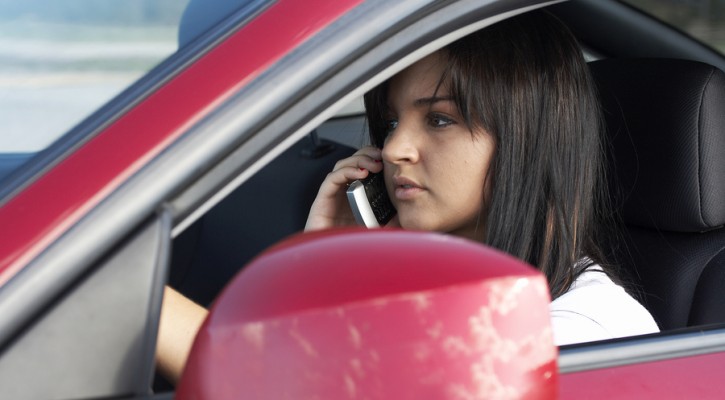Category Archive: Mobile Phones

Some Teen Safe Driving Choices Are Still Dangerous
December 17, 2015
Researchers at the Children’s Hospital of Philadelphia recently conducted a study to gauge teen attitudes on safe driving choices regarding cell phones. The researchers saw some encouraging signs but say there’s still a long way to go before cell phone use by teens while driving is a thing of the past.
To conduct their research, the researchers conducted several focus groups with 16 to 18 year old drivers. The questions asked of the teen drivers were designed to get an overall view of teen perceptions regarding cell phone use while driving with the intent of gathering information to help develop future interventions to reduce risky driving choices by teens.
According to the head researcher, Catherine McDonald, PhD, RN, it was encouraging to see that teens recognized that cell phone use, texting, and use of social media are dangerous behind-the-wheel. When asked what methods teens used to prevent the use of cell phones while driving, some teens listed methods such as turning off the cell phone or pulling off the road before making or answering a call. However, some teens listed choices such as waiting for a red light or until they were on familiar roads before diverting their attention to the cell phone.
While it’s good that they are considering ways to reduce their cell phone use, those choices such as waiting for red lights or familiar roads are still dangerous choices that take their eyes and mental attention off the road.
- Choosing to use hands-free communication devices has been shown to be no safer than the use of hand-held devices.
- A driver’s attention at red lights is important too. Not noticing that the light has turned green can hold up traffic behind and lead angry drivers to try to retaliate.
- Research shows that hands-free devices are still distracting for up to 27 seconds after hanging up.
- Waiting for familiar roads is a bad choice because most traffic collisions happen within 25 miles of home and at speeds below 45 mph. Drivers become complacent on those familiar roads and that leads to even more distractions.
According to the researchers, until more effective methods are developed to pry teens away from their cell phones while driving, parents are still the primary influence in promoting safer choices by teens. Setting a good example and insisting on strict rules for cell phone use while driving, parents can help keep their teens safe on the road.

Texting and Walking Injuries Are Increasing
August 31, 2015
Texting and walking injuries and deaths are on the rise according to a new report released by the Governors Highway Safety Administration (GHSA) and the danger is especially high for teens. The report is a compilation of several studies including data compiled by Ohio State University, the University of Washington, the University of Georgia, and the Pew Research Center.
According to the Ohio State research, “between 2004 and 2010 the number of pedestrians killed while using a cell phone increased from less than 1% to 3.6%” and, in 2010, more than 1,500 pedestrians were estimated to be treated for injuries related to cell phone use while walking. Since 2005, the number of pedestrians injured while using a cell phone has more than doubled.
The Washington State researchers observed more than 1,100 pedestrians at 20 intersections in Seattle and found that “approximately one-third were engaged in a distracting activity such as emailing, talking to another person or listening to music.”
The University of Georgia researchers did a similar study but selected 20 intersections that were considered to be high risk based on data from the Georgia Department of Transportation. Their study showed that nearly half of pedestrians were engaged in some sort of distracting behavior.
A Pew Research Center survey found that 53 percent of adult cell phone users have bumped into something or someone due to distracted walking. The bump rate is especially high for those in the 18 to 24 year age group.
The problem is especially bad for teens who do this on a regular basis. Safe Kids Worldwide reports that forty percent of teens have been hit or nearly hit by a car, bike or motorcycle while walking. Their report shows that one out of five teens and one out of eight middle schoolers regularly cross the street while distracted by some sort of technology. Teens now have the highest pedestrian death rate among children 19 and younger.
The problem has become so bad that the Urban Dictionary has coined a new phrase for it: Petextrian n. One who texts while walking, usually unaware of their surroundings.
It’s obvious that, if you can’t even text and walk safely, texting while driving is out of the question.
Read more: Everyone Walks

Parents May Be Distracting Their Teen Drivers
August 12, 2014
Parents may be distracting their teen drivers by calling to check up on them. According to research presented at the American Psychological Association’s annual convention, more than half of teens responding to a survey said they were on the phone with a parent while driving. Continue Reading

“Selfies” While Driving Are Dangerous
February 26, 2014
With all the discussion about cell phones and texting while driving, we should also talk about the new phenomenon of “selfies.” Selfies are the act of taking self-portraits with cell phones and they are cropping up everywhere. One has only to look at a young person’s Facebook page to see a selfie or two. Selfies of celebrities and politicians are also showing up on Twitter and in newspapers.
Taking a selfie while driving though can be extremely dangerous. Taking a selfie requires that you look at the camera (and not the road) and wait while the camera focuses and snaps the picture. Just the act of setting up the camera on a smart phone to take the picture can take time and distract a driver long enough to lead to a collision.
It’s important to remember how much distance is covered while posing for a selfie. At 45 mph, a car will travel more than 66 feet per second. For a driver looking at the camera and taking a picture, those two to three seconds mean that the vehicle has traveled from 132 to 198 feet. That’s two-thirds the distance of a football field. A lot can happen in that distance and a driver’s attention needs to be on the road ahead.
Along with selfies, taking videos of passengers or objects outside the window can be just as distracting. In a video making the rounds on social media, a mother videoing the actions of her kids in the back seat almost turned a precious moment with her children into a tragedy. The video can be seen at: http://www.liveleak.com/view?i=60d_1392830284
Warning! There’s a little bit of foul language in the video.

Distracted Driving Awareness Month Increases Attention, Debate
April 10, 2012
April is in full swing and with it has come Distracted Driving Awareness Month. Being observed throughout the United States, the month serves to raise general awareness and point the attention of lawmakers and automakers towards safer regulations to make the roads safer. Aside from the numerous events going on throughout the country, heavy debate has been sparked on the automakers side, as in car technology has now become a large topic of discussion.
Talks in Washington D.C. have involved major discussion over the impact that built in gps and stereo systems are having on the attention span of drivers these days. Lawmakers are calling for the vehicle manufacturers to tone down their entertainment. GPS modules and entertainment/stereo systems are certainly continuing to grow, becoming more complex along with the times.
Just as many are pointing towards automakers to help minimize risk in these times, they car companies are looking for accountability from technology developers. Certainly smart phone developers and portable GPS makers share some responsibility for the impact their products have had, but options are somewhat limited from a lawmaking standpoint.
Automakers are seemingly determined to work out efforts, however. It was reported that they are attempting to work with cell phone developers in an effort to fight cases of distracted driving. The National Transportation Safety Board has called to have more integration with cell phones into the cars, allowing for more hands free use, and eventually a positive impact on the road.
It will take some response from the cell phone developers, however. Right now, these companies have done little to come to the table and discuss possible options. Hopefully the increasing cases of distracted driving will highlight the need for these developers to work on a plan to help minimize future road problems.
Laws relating to distracted driving are heavily different throughout the United States. Around 35 states currently have a full ban on text messaging, while nine have a full ban on the use of hand held cell phone devices. Just recently, the city of Chapel Hill, NC made news by becoming the first town to enact a ban on cell phone use while driving.
The impact of the recent Chapel Hill law, going along with Distracted Driving Awareness Month taking place this month will be far reaching from adults to teenagers. There are a number of states where stricter laws may be necessary to minimize distracted driving cases in the future, while attention will certainly come upon automakers and technology developers as well. All in all, the awareness month in 2012 serves to increase attention to one of the great dangers today and will continue to do so in coming years.
